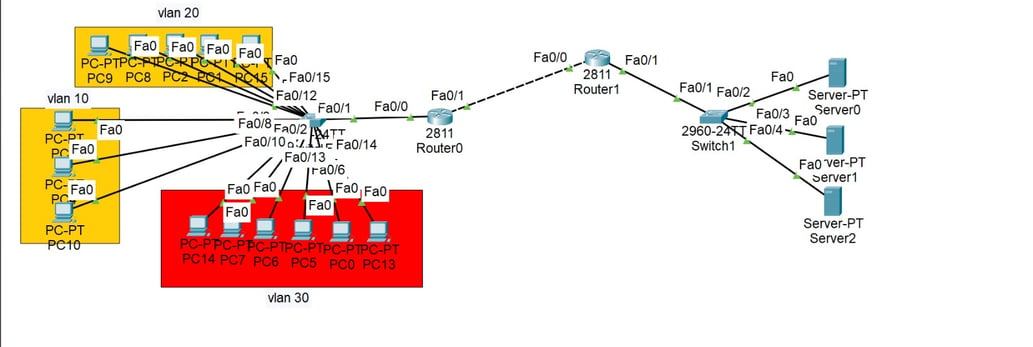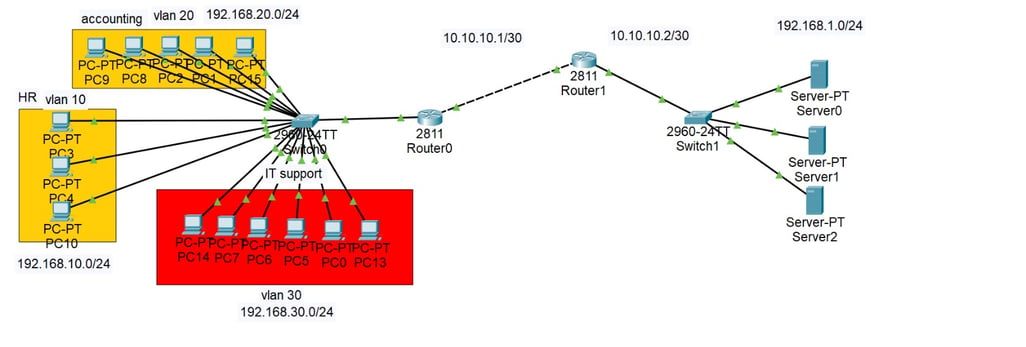CCNA project-VLAN
Embark on a CCNA project with Hussien almelhem as we explore the power of VLANs! Learn how to segment your network, enhance security, and optimize traffic routing. Dive deep into VLAN configuration and management. Elevate your networking skills with this hands-on project. #CCNA #Networking #VLANs #NetworkSegmentation
hussien almelhem
9/15/20233 min read

VLAN projects
In the realm of network management, the construction of a Virtual Local Area Network (VLAN) project is a complex undertaking. This article explores the step-by-step process of building a VLAN network, from inception to realization, focusing on the experiences and challenges faced by network administrator Hussein Almelhem.
Steo1: Project Initiation and Planning
Hussien Almelhem commenced the VLAN project by clearly defining its objectives and scope. His primary goal was to optimize network performance, enhance security, and simplify network management. He diligently identified key stakeholders and gathered their requirements, ensuring that their needs would be met. Hussein then formulated a project plan that included timelines, budgets, and resource allocation, and he assigned specific roles and responsibilities to his team members.
Step 2: Network Assessment
Hussien Almelhem knew that a solid foundation was crucial, so he undertook an extensive network assessment. He analyzed the existing network infrastructure, meticulously examining the network topology, traffic patterns, and security requirements. This assessment served as a blueprint for the VLAN design, helping Hussein pinpoint the specific network segments that required VLAN segmentation.
Step 3: Design VLANs
Designing the VLANs was a pivotal phase in the project. Hussien Almelhem created a VLAN design tailored to the organization's unique needs while keeping scalability for future growth in mind. He defined VLAN IDs and IP subnets for each VLAN and meticulously planned the membership and access controls. The design became the guiding framework for the entire project.
Step 4: Equipment and Hardware Procurement
To bring his VLAN project to fruition, Hussien Almelhem needed to procure the necessary networking equipment. He carefully selected switches, routers, and access points that supported VLAN configurations, ensuring compatibility with the VLAN design and alignment with the network's performance requirements.
Step 5: Configuration and Implementation
The configuration and implementation phase marked a transition from planning to action. Hussien Almelhem assigned VLAN IDs and IP subnets to network segments, configured VLAN interfaces on routers to enable inter-VLAN routing, and fine-tuned port assignments and VLAN membership for each switch port. Where necessary, he implemented VLAN tagging (802.1Q) to facilitate seamless communication between VLANs.
Step 6: Access Control and Security
Security was a top priority for Hussien Almelhem throughout the project. He implemented access control lists (ACLs) to control traffic flow between VLANs and enforced robust security policies to safeguard sensitive data and resources. The strategic use of network segmentation further bolstered the organization's security posture.
Step 7: Testing and Verification
Hussien Almelhem conducted rigorous testing and verification to ensure that the VLAN configurations met performance expectations. He meticulously verified that devices within each VLAN could communicate as intended and thoroughly tested inter-VLAN routing functionality. Any necessary adjustments were made to guarantee seamless operation.
Step 8: Documentation and Documentation
Documentation played a pivotal role in Hussien Almelhem's project. He created comprehensive documentation that encompassed VLAN IDs, IP subnets, port assignments, and security policies. Network diagrams were used to visualize the VLAN topology while troubleshooting procedures and recovery plans were essential references.
Step 9: Training and Knowledge Transfer
Hussien Almelhem believed in empowering his team with the knowledge and skills required for effective VLAN management. He organized training sessions to ensure that his colleagues were well-versed in the VLAN design and configurations, facilitating knowledge transfer as an ongoing commitment.
Step 10: Monitoring and Maintenance
After the VLANs were operational, Hussien Almelhem established continuous monitoring. Network monitoring tools kept a vigilant eye on VLAN performance and security, while routine maintenance ensured that configurations remained up-to-date to meet evolving requirements. Monitoring network traffic enabled proactive issue resolution.
Step 11: Project Review and Evaluation
Reflecting on the project's success, Hussien Almelhem conducted a post-implementation review. He gathered feedback from users and colleagues, identified areas for improvement, and distilled valuable lessons learned during the project.
Step 12: Documentation Update and Knowledge Management
As the network evolved, so did Hussien Almelhem's documentation. He diligently updated documentation to reflect changes made during and after the project, ensuring that VLAN configurations remained accessible and actionable. Effective knowledge management.









